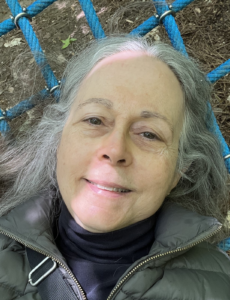
Weaving
I am an artist whose medium is weaving. The first version of this website was put up in 1996 so that I could share information on loom controlled shibori with a weaver on another coast. Later that year, I created the Weavers Guild of Boston website, which I maintained through early 2000.
|
I became a weaver during a three week course at Haystack Mountain School of Crafts in 1994. Later, I took weaving classes at the University of Massachusetts Dartmouth and the Rhode Island School of Design. In May 1999, I completed a certificate in textile design at Philadelphia College of Textiles and Science (now part of Jefferson University). There I studied Jacquard design and investigated lye cloque and multi-weft double weave. Since then, I have been creating imagery in my weaving. Initially, I did so using multi-weft double weave pickup. Early in 2002, I was introduced to the benefits of the Thread Controller TC-1 loom at a workshop hosted by the Potomac Craftsmen Guild in Washington, DC. In June 2003, I took an week long Jacquard design workshop taught by Louise Lemieux Berube at the Montreal Center for Contemporary Textiles and promptly ordered a TC-1 loom on returning home. I design for my TC-1using ArahWeave PE and Adobe PhotoShop as design tools. I was on a weaving hiatus for over ten years until I retired in the spring of 2020 as the world went into lock down. In fall 2020, I got a 32 shaft Louet Megado loom and began renewing my acquaintance with weaving. |
Software
I was a professional software developer for almost 40 years. I worked as a web developer from 1997 until 2021.
I began writing weaving software for my own use in 1996 to fill in gaps between commercial weave design programs. After my class at RISD, I did not want to lose the drafts I had created in class using WeavePoint. Support for WIF text files had recently been added in my main weaving program, Swiftweave. The first weaving program I wrote translated WeavePoint and ProWeave drafts into WIF drafts. It was named QDWif (the QD stood for Quick and Dirty) and was available on this website as freeware. Commercial weaving programs eventually added support for WIF, so the need for QDWif disappeared.
To help myself design drafts for double weave pickup, I created my first weaving web app. An improved version of of this web app, Multi-weft Double Weave Drafter, is available on this website.
While waiting for my TC-1 loom to arrive, I wrote a weaving program named Wif2Tiff that read WIF files and generated TIFF image files. I planned to use it to create weave image files to import into ArahWeave PE. Wif2Tiff was available on this website for several years. It has been replaced by my web application, WIF Visualizer.
While Bhakti Ziek and Alice Schlein were working on their book The Woven Pixel, they asked me to write a weaving program to translate Jacquard card images into Staubli JC5 files. This collaboration resulted in the program Gif2BeljenJC5 that translated GIF card images designed for the Beljen Mills’ jacquard loom into JC5 files. This program was available on this website until Beljen Mills closed down. Writing Gif2BeljenJC5 led me to weaving several of my own designs at Beljen Mills.
